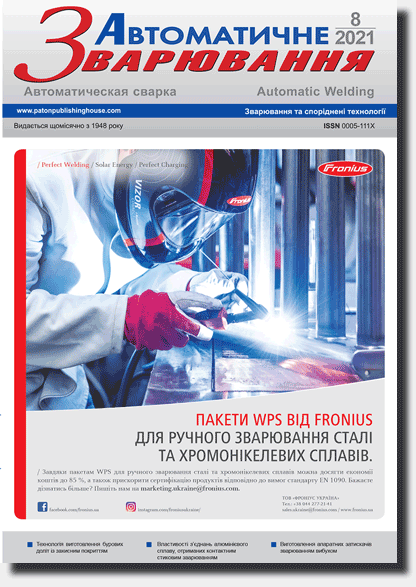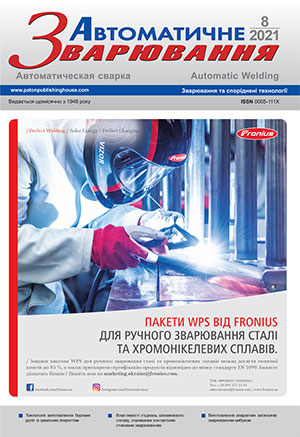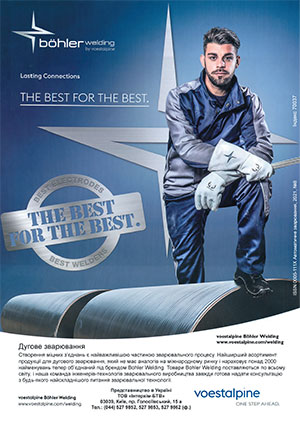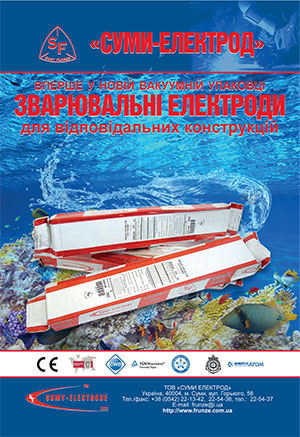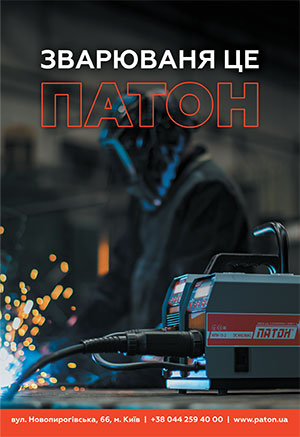| 2021 №08 (01) |
DOI of Article 10.37434/as2021.08.02 |
2021 №08 (03) |
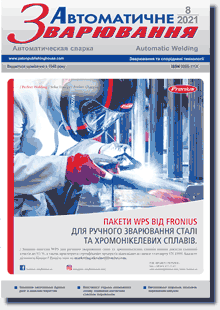
"Avtomatychne Zvaryuvannya" (Automatic Welding), #8, 2021, pp. 9-13
Influence of longitudinal controlling magnetic field on the effectiveness of arc surfacing process
O.D. Razmyshlyaev1, M.V. Ageeva2, O.G. Bilyk1, E. Khaled1
1SHEI «Priazovskyi State Technical University». 7 Universitetskaya str., Mariupol, 87500. E-mail: office@pstu.edu
2Donbas State Mechanical Engineering Academy. 72 Akademichna Str., Kramatorsk, 84300
Literature data review showed that the longitudinal magnetic field (LMF) is used to increase the process effectiveness at arc surfacing and welding. At surfacing and welding with LMF impact, the electrode metal melting rate increases, control of the cross-sectional geometrical dimensions of the deposited bead and weld becomes possible, the structure of the deposited metal and welds is refined, and hardness, strength and ductility of weld metal, as well as hot cracking resistance of the welds become higher. It was established that effective stirring of liquid metal in the weld pool, i.e. along its entire length, should be ensured for refinement of structural components of the metal deposited under LMF impact. Here, optimum parameters of the controlling magnetic fields should be provided. In this work, experiments were performed on submerged-arc surfacing of plates from 20 mm thick low-carbon steel with 5 mm Sv-08A wire under the impact of LMF at the following frequencies: 5, 10, 20, 33 and 50 Hz. The magnitude of the longitudinal component of magnetic field induction Вz was 30...40 mT, when measured under the electrode at the surface of the plate product. The influence of LMF frequency on base metal penetration depth and deposited bead width was studied. It is found that at LMF frequencies in the range of f = 5…50 Hz, the penetration depth is smaller, while the bead width is greater than at surfacing without LMF application. 25 Ref., 4 Fig.
Keywords: submerged-arc surfacing, welding wire, controlling magnetic field, optimum modes, welded joint quality
Received: 08.06.2021
References
1. Chernysh, V.P., Kuznetsov, V.D., Briskman, A.N., Shelenkov, G.M. (1983) Welding with electromagnetic stirring. Kiev, Tekhnika [in Russian].2. Razmyshlyaev, A.D. (2000) Magnetic control of weld formation in arc welding. Mariupol, PGTU [in Russian].
3. Razmyshlyaev, A.D., Mironova, M.V. (2009) Magnetic control of bead and weld formation in arc surfacing and welding. Mariupol, PGTU [in Russian].
4. Razmyshlyaev, A.D., Vydmysh, P.A., Ageeva, M.V. (2017) Automatic submerged arc welding under action of external magnetic field. Mariupol, PGTU [in Russian].
5. Razmyshlyaev, A.D., Maevsky, V.R., Sidorenko, S.M. (2001) Calculation of magnetic field induction of solenoid with ferromagnetic core for arc surfacing. The Paton Welding J., 8, 18-21.
6. Razmyshlyaev, A.D., Deli, A.A., Mironova, M.V. (2007) Effect of longitudinal magnetic field on efficiency of wire melting in submerged-arc surfacing. Ibid., 6, 23-27.
7. Boldyrev, А.М., Birzhev, V.A., Chernykh, A.V. (1990) Increasing the melting efficiency of electrode wire in welding in a longitudinal magnetic field. Welding Intern., 4(9), 746-748. https://doi.org/10.1080/09507119809447812
8. Razmyshlyaev, A.D., Mironova, M.V., Deli, A.A. (2007) Influence of longitudinal magnetic field frequency on melting coefficient of wire in submerged arc surfacing. Visnyk PDTU, 17, 150-152 [in Russian].
9. Razmyshlyaev, A.D., Maevsky, V.R. (1996) Influence of controlling magnetic fields on geometrical dimensions of welds in submerged arc welding. Svarochn. Proizvodstvo, 2, 17-19 [in Russian].
10. Razmyshlyaev, A.D. (1996) Influence of magnetic field on dimensions of penetration zone in submerged arc surfacing. Avtomatich. Svarka, 8, 25-27, 30 [in Russian].
11. Boldyrev, A.M., Birzhev, V.A., Chernykh, A.V. (1993) Control of penetration depth in arc welding and surfacing by longitudinal variable magnetic field. Svarochn. Proizvodstvo, 6, 30-31 [in Russian]. https://doi.org/10.1080/09507119209548292
12. Razmyshlyaev, A.D., , Mironova, M.V. (2008) Peculiarities of base metal penetration in arc surfacing in longitudinal magnetic field. The Paton Welding J., 8, 24-28. https://doi.org/10.1080/09507111003655531
13. Tyumentsev, I.G., Polishchuk, S.V. (2006) Influence of the variable magnetic field on structural strength of highstrength welded joints. In: Proc. of Int. Sci.-Pract. Conf. on Actual Problems of Electrometallurgy, Welding, Quality (Novokuznetsk, 25-26 May 2006). Vol. 2, SibGIU, Novokuznetsk, 83-84.
14. Tyumentsev, I.G., Polishchuk, S.V., Tyumentsev, M.I. et al. (2007) Energy method of evaluation of weld metal strength under impact loading produced by welding under crystallization conditions in longitudinal magnetic field. In: Proc. of All-Russian Sci.-Pract. Conf. on Metallurgy: New Technologies, Management, Innovation and Quality (Novokuznetsk, 16-19 October 2007). SibGIU, Novokuznetsk, 191-193 [in Russian].
15. Sutyrin, G.V. (1975) Investigation of mechanism of low-frequency vibration action on weld pool crystallization. Avtomatich. Svarka, 5, 7-10 [in Russian].
16. Aristov, S.V., Russo, V.L. (1982) Weld metal crystallization in low-frequency oscillations of melt. Svarochn. Proizvodstvo, 11, 42-44 [in Russian].
17. Karpov, V.M., Li, D.S., Voropaev, A.O. et al. (2014) Influence of electromagnetic stirring on structure of weld metal produced by automatic underwater welding. Mor. Intellekt. Tekhnol., 4(1), 80-84 [in Russian].
18. Morozov, V.P. (2010) Influence of oscillating mechanism of crystallization on the process of primary structure refinement of the weld metal and heat-affected zone. Nauka i Obrazovanie, MGTU, 9, 1-8 [in Russian].
19. Morozov, V.P. (2010) Determination of the relation between periodicity of the weld metal crystallization process, changes of instantaneous solidification speed and values of technological strength. Ibid., 9, 3-9 [in Russian].
20. Morozov, V.P. (2010) Influence of the external pulsating heat source on melted weld metal during its crystallization for efficient control of structure formation. Ibid., 10, 4-8 [in Russian].
21. Boldyrev, A.M., Dorofeev, E.V., Antonov, E.G. (1971) Control of metal crystallization in fusion welding. Svarochn. Proizvodstvo, 6, 35-37 [in Russian].
22. Ageeva, M.V., Razmyshlyaev, A.D. (2019) About stirring of melt in weld pool in electric arc surfacing in longitudinal magnetic field. In: Proc. of 7th Sci. Conf. on Fundamental and Applied Research in Modern Science (Kharkiv, 30 October 2019). Kharkiv, Technological Center, 54 [in Russian].
23. Razmyshlyaev, A.D., Ageeva, M.V. (2019) Refinement of metal structure in arc surfacing under the effect of longitudinal magnetic field. The Paton Welding J., 2, 19-21. https://doi.org/10.15407/tpwj2019.02.03
24. Razmyshlyaev, A.D., Ageeva, M.V. (2019) Influence of magnetic field on crystallization of welds in arc welding. Ibid., 1, 25-27. https://doi.org/10.15407/tpwj2019.01.05
25. Razmyshlyaev, A.D., Ageeva, M.V. (2018) On mechanism of weld metal structure refinement in arc welding under action of magnetic field (Review). Ibid., 3, 25-28. https://doi.org/10.15407/tpwj2018.03.05
Advertising in this issue:
The cost of subscription/purchase order journals or individual articles
| Journal/Currency | Annual Set | 1 issue printed |
1 issue |
one article |
| TPWJ/USD | 384 $ | 32 $ | 26 $ | 13 $ |
| TPWJ/EUR | 348 € | 29 € | 24 € | 12 € |
| TPWJ/UAH | 7200 UAH | 600 UAH | 600 UAH | 280 UAH |
| AS/UAH | 1800 UAH | 300 UAH | 300 UAH | 150 UAH |
| AS/USD | 192 $ | 32 $ | 26 $ | 13 $ |
| AS/EUR | 180 € | 30 € | 25 € | 12 € |
| SEM/UAH | 1200 UAH | 300 UAH | 300 UAH | 150 UAH |
| SEM/USD | 128 $ | 32 $ | 26 $ | 13 $ |
| SEM/EUR | 120 € | 30 € | 25 € | 12 € |
| TDNK/UAH | 1200 UAH | 300 UAH | 300 UAH | 150 UAH |
| TDNK/USD | 128 $ | 32 $ | 26 $ | 13 $ |
| TDNK/EUR | 120 € | 30 € | 25 € | 15 € |
AS = «Automatic Welding» - 6 issues per year;
TPWJ = «PATON WELDING JOURNAL» - 12 issues per year;
SEM = «Electrometallurgy Today» - 4 issues per year;
TDNK = «Technical Diagnostics and Non-Destructive Testing» - 4 issues per year.





